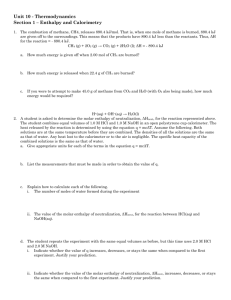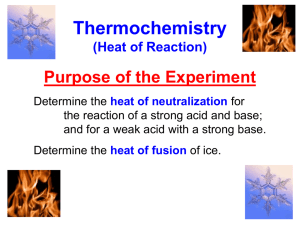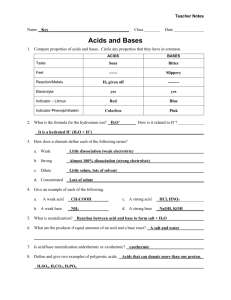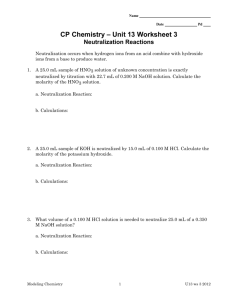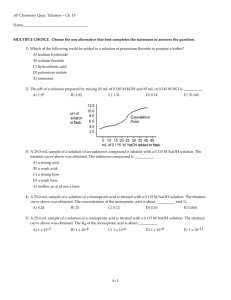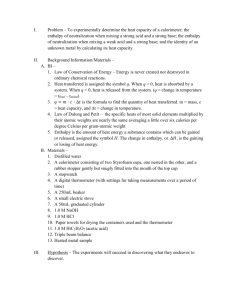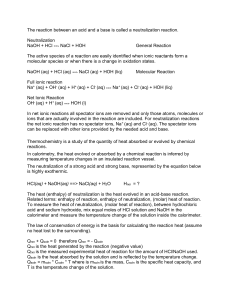Heat of Neutralization Lab
advertisement
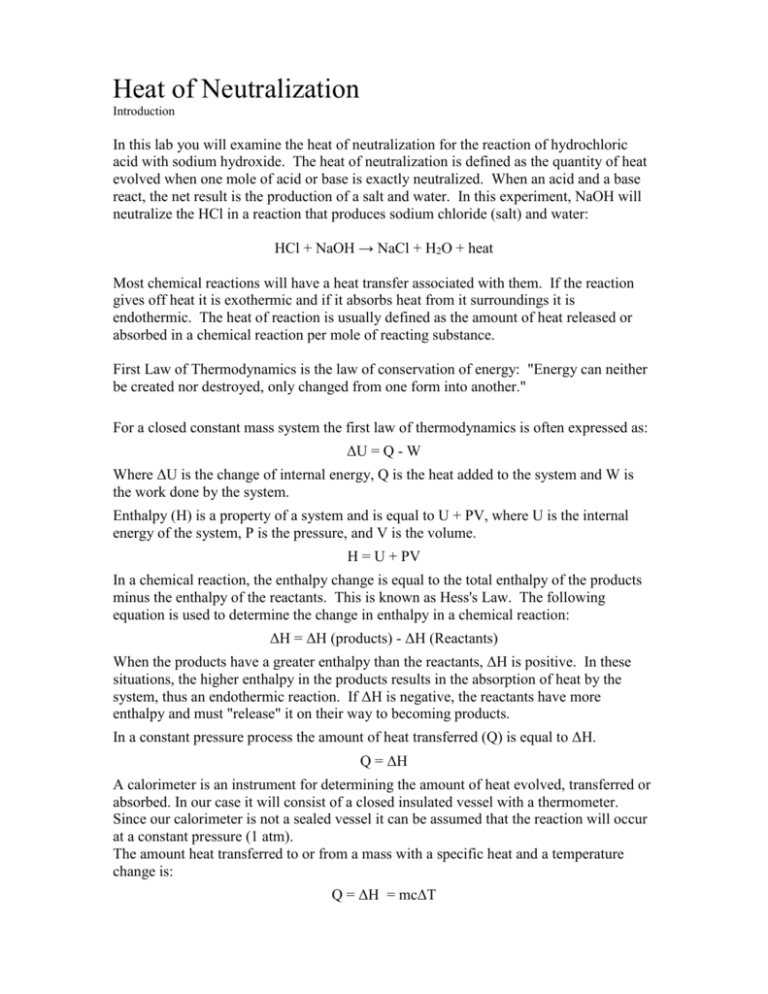
Heat of Neutralization
Introduction
In this lab you will examine the heat of neutralization for the reaction of hydrochloric
acid with sodium hydroxide. The heat of neutralization is defined as the quantity of heat
evolved when one mole of acid or base is exactly neutralized. When an acid and a base
react, the net result is the production of a salt and water. In this experiment, NaOH will
neutralize the HCl in a reaction that produces sodium chloride (salt) and water:
HCl + NaOH → NaCl + H2O + heat
Most chemical reactions will have a heat transfer associated with them. If the reaction
gives off heat it is exothermic and if it absorbs heat from it surroundings it is
endothermic. The heat of reaction is usually defined as the amount of heat released or
absorbed in a chemical reaction per mole of reacting substance.
First Law of Thermodynamics is the law of conservation of energy: "Energy can neither
be created nor destroyed, only changed from one form into another."
For a closed constant mass system the first law of thermodynamics is often expressed as:
ΔU = Q - W
Where ΔU is the change of internal energy, Q is the heat added to the system and W is
the work done by the system.
Enthalpy (H) is a property of a system and is equal to U + PV, where U is the internal
energy of the system, P is the pressure, and V is the volume.
H = U + PV
In a chemical reaction, the enthalpy change is equal to the total enthalpy of the products
minus the enthalpy of the reactants. This is known as Hess's Law. The following
equation is used to determine the change in enthalpy in a chemical reaction:
ΔH = ΔH (products) - ΔH (Reactants)
When the products have a greater enthalpy than the reactants, ΔH is positive. In these
situations, the higher enthalpy in the products results in the absorption of heat by the
system, thus an endothermic reaction. If ΔH is negative, the reactants have more
enthalpy and must "release" it on their way to becoming products.
In a constant pressure process the amount of heat transferred (Q) is equal to ΔH.
Q = ΔH
A calorimeter is an instrument for determining the amount of heat evolved, transferred or
absorbed. In our case it will consist of a closed insulated vessel with a thermometer.
Since our calorimeter is not a sealed vessel it can be assumed that the reaction will occur
at a constant pressure (1 atm).
The amount heat transferred to or from a mass with a specific heat and a temperature
change is:
Q = ΔH = mcΔT
where m is the mass solution in grams, c is specific heat capacity of our solution {4.184
J/(˚C g)} and ΔT = Tmax – Tinitial.
Heat of Neutralization (ΔHneut) = Q/moles of limiting reactant
In this experiment we will plot the pH and solution temperature against the amount of
base added to produce a titration curve. The steepest point on the pH curve occurs at the
equivalence point, when the acid is exactly neutralized. This also is the point of
maximum temperature for the solution.
Heat of Neutralization
Procedure
**NOTE: Use instructions provide by the instructor – DO NOT USE INSTRUCTIONS
IN CHEMLAB! To remove the instructions on the screen, and free-up more working
area, perform the following operation: click on the OPTIONS tab; then click on LAB
ONLY. The instructions “disappear” and all of the area is now lab space.**
Step 1: Obtain a calorimeter from the Equipment menu.
Step 2: Select the calorimeter and add 25 mL of 1M HCl using the Chemicals dialog box.
Step 3: Obtain a 50 mL buret from the Equipment menu.
Step 4: Select the buret and fill with 50 mL of 1 M NaOH, using the Chemicals dialog
box.
Step 5: Select the calorimeter and add a pH meter from the Equipment menu – this will
appear as a pH label below the calorimeter.
Step 6: Select the calorimeter and turn-on the collection of titration data using the
Procedure menu for Collect Titration Data.
Step 7: Select View Titration Data from the Procedures menu.
Step 8: Start titrating the NaOH into the calorimeter, you should see a plot of “mL(s)
titrate” vs pH and temperature in the Titration Data window.
Step 9: Titrate all the NaOH into the calorimeter – note the point at which the
temperature reaches it maximum.
Step 10: Provide a title for your titration curve by selecting options from the file menu.
Step 11: Copy the LABELED titration curve from the Titration data window to Word.
Use the copy from the Titration data window's edit menu and paste into Word – print
your titration curve.
Heat of Neutralization
Observations
Name:__________
Section:_________
Data
Initial solution temperature (˚C):
˚C
Maximum solution temperature (˚C):
˚C
Recall that the steepest point on the pH curve occurs at the equivalence point, that is,
when the acid is exactly neutralized.
Total volume of NaOH titrated to reach end-point or neutralization:
(steepest point on the pH curve):
mL
Calculations
1) Calculate the mass of the solution, at the equivalence point, using the following
formula:
Mass of solution (g) = (Volume of NaOH titrated (ml) + Volume of HCl (ml)) x density
Note: Assume a density of 1.038 g/mL for both NaOH and HCl
mass of the solution:
g
2) Calculate the total heat released by neutralization using the following formula:
Q = mcΔT
where Q is the heat released at the equivalence point, m is the mass solution in grams, c =
specific heat capacity of our solution {4.184 J/(˚C g)} and ΔT = Tmax – Tinitial.
Total heat released by neutralization:
J
3) Calculate the Heat of Neutralization using the following relationships:
Heat of Neutralization = Q/moles of limiting reactant
Heat of Neutralization = Q/moles of NaOH titrated at neutralization
Heat of Neutralization = Q/(Molarity of NaOH x volume of NaOH (in litres))
Heat released by neutralization:
kJ/mol
Questions
1) Define the system and the surroundings for the reaction studied in this experiment.
Since water was one of the products, does it belong in the system or in the surroundings?
________________________________________________________________________
________________________________________________________________________
________________________________________________________________________
________________________________________________________________________
________________________________________________________________________
________________________________________________________________________
2) Why does the temperature increase, reach a maximum, and then decrease for this
titration?
________________________________________________________________________
________________________________________________________________________
________________________________________________________________________
________________________________________________________________________
________________________________________________________________________
Discussion

